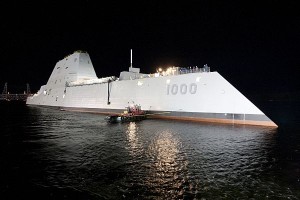 Stealth! Low observables! Reduced signatures! Wake reduction! It’s all the rage in naval warfare…Modern navies just won’t leave home without a full suite of pricey features deemed necessary to make a 16,000 ton DDG-1000 dwindle away to a rowboat-sized radar blip.
Stealth! Low observables! Reduced signatures! Wake reduction! It’s all the rage in naval warfare…Modern navies just won’t leave home without a full suite of pricey features deemed necessary to make a 16,000 ton DDG-1000 dwindle away to a rowboat-sized radar blip.
But…outside of that uncomfortable moment when, say, an anti-ship missile starts seeking your vessel, just how important is all this stealthy signature-reduction stuff, really?
On LCS-2, the USS Independence, radar cross-section was likely compromised for the convenience of bridge-wings. On DDG-1002, the much-ballyhooed radar-reducing composite deckhouse was sacrificed for lower-cost steel. And the changes went forward with no public discussion of the advantages/disadvantages beyond, well, raw cost. I’d like to think there was some detailed discussion of the potential tradeoffs made on these platforms, but….I’m a bit of a pessimist.
So…if signature regularly loses to cost and convenience, just how important is it all, really?
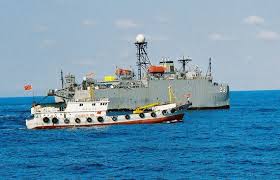 Are stealth features just the maritime equivalent of “curb feelers” and “sunroofs”–you know, those cool, high-margin but ultimately un-necessary gadgets your, ah, “friendly” car dealer pushes the hoi polloi to purchase?
Are stealth features just the maritime equivalent of “curb feelers” and “sunroofs”–you know, those cool, high-margin but ultimately un-necessary gadgets your, ah, “friendly” car dealer pushes the hoi polloi to purchase?
If anything, many of the stealth/signature reduction features available to the fleet are useful/used in a relatively narrow subset of circumstances (and, I might add, quickly defeated by technological advances…or defeated because they weren’t enabled, turned-on, etc.). Might it be more useful to explore and invest in old-school passive stealth features that can pay off during day-to-day use?
I mean, old-school camouflage never gets old. And as the lines between civilian and military platforms begin to really blur (Exhibit “A” would be China’s maritime militia), I am beginning to wonder if true surface stealth may come from adopting Mao Tse-tung’s idea that a guerrilla “can always sink back into the peaceful population which is the sea in which the guerrilla swims like a fish.” This old adage is certainly applicable to the maritime domain–Surface combatants have a long and storied history of using deception for competitive advantage and of blending into peaceful shipping traffic (Q-ships offer one of many fun examples).
Why not take some time to exploit the potential of a low-to-no profile naval vessel?
Under certain circumstances, a Navy platform that could look and sound…and emit like civilian traffic seems like stealth gold. And, well, I suspect running about in a civilian-esque ship is an “enhancement” that costs a heck of a lot less than, say, the DDG-1000’s radar-reducing composite deckhouse.
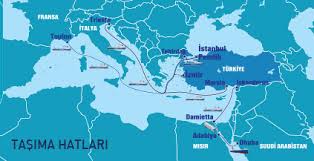 Take the M/V Cragside, for example. After getting a $80 Million-dollar facelift, this fascinating Special-Ops cruise ship will still look like any number of innocuous Turkish-owned ferries or Flensburger Ro-Ros that currently rattle around the Med and (cough) the, um, Black Sea. So it certainly could blend into shipping traffic in some awfully interesting parts of the world (a partial route map for one is above).
Take the M/V Cragside, for example. After getting a $80 Million-dollar facelift, this fascinating Special-Ops cruise ship will still look like any number of innocuous Turkish-owned ferries or Flensburger Ro-Ros that currently rattle around the Med and (cough) the, um, Black Sea. So it certainly could blend into shipping traffic in some awfully interesting parts of the world (a partial route map for one is above).
Yes, the run-of-the-mill, 20,000 ton ferry isn’t as dramatic as a tumblehome DDG-1000, but, gosh, there’s a certain comfort of not getting looked at twice.
It’s a question of where the best value actually is…is it better to avoid being targeted or better to avoid being detected? I don’t know…they are different sides of the same coin, each with their own set of advantages and disadvantages.
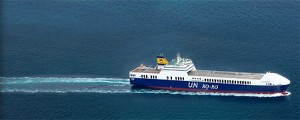 But, given that the U.S. Navy has come down on the side that favors tactical advantage in a conventional maritime confrontation, let’s try to explore the contrarian view and enumerate some scenarios where hiding in plain sight may be beneficial.
But, given that the U.S. Navy has come down on the side that favors tactical advantage in a conventional maritime confrontation, let’s try to explore the contrarian view and enumerate some scenarios where hiding in plain sight may be beneficial.
When Does Hiding In Plain Sight Work?
Is the target unaware? The target’s ISR and intel must be patchy. Hiding in plain sight won’t work if you’re up against an adversary who has complete, 24/7, nobody-ever-sleeps awareness of the maritime domain. However, if that target’s ISR capabilities either depends upon the Mark I, Mod I eyeball–or is expected to rapidly degrade to the Mark I, Mod I eyeball, then employing platforms capable of blending with existing civilian traffic may be useful.
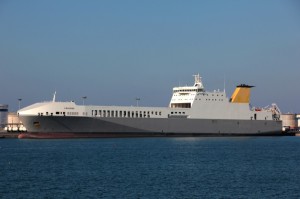 Is the target hoarding ammo? Anti-ship missiles aren’t cheap. If the target has only a handful of missiles–and a viable “identified” threat nearby, then they’ll think twice before targeting something that looks innocuous.
Is the target hoarding ammo? Anti-ship missiles aren’t cheap. If the target has only a handful of missiles–and a viable “identified” threat nearby, then they’ll think twice before targeting something that looks innocuous.
Is the environment right? Is the region crowded with civilian traffic–of the type that matches our “stealth” platform? And, in particular, do my “stealth” platforms match/mimic those of a relatively powerful neighbor or associate? Would the target’s fear of real and immediate consequences from a miscalculation be sufficient for the target to require additional verification before targeting?
Are there friends nearby? This sort of stealth works for only as long as the target is convinced that the platform is not hostile—but the moment the ship like the M/V Cragside gets “found out”, then there’d better be some friendly traditional combatants to hide behind.
It would be interesting to take some naval architects into a basement someplace and determine just how combatant-like (or, to use the Christina Fox/DOT&E vernacular, how “survivable”) these navalized merchant/fishing/workboat-type ships could become without sacrificing the basic civilian ship lines (and while still satisfying the Rules-Of-War lawyers, too).
I assume we will soon find out, because the route from auxiliary CONEX-box mover to amphib-lite to combatant is pretty short…and mighty cost-effective. Who knows?

{ 2 trackbacks }
{ 12 comments… read them below or add one }
Pulse Doppler techniques, used to detect cruise missiles, are different from the techniques used to detect surface ships. Not sure you can really translate performance in one area to performance in the other.
But yes, ~50m2 class surface RCS really doesn’t prevent detection the way 0.0001m2 RCS does with aircraft.
Focusing on the LACM/ASCM problem, if we are looking for wave hoppers that are ‘hard’, those semi-stationary things with wave clutter around them that you call ‘ships’ show up for free.
If the surveillance net has the capabilities to spot things and pass those tracks, the fact that antiship missile’s autonomous acquisition basket is smaller doesn’t help enough to assure you can collect retirement pay.
J_kies,
What netted sensors are being designed around detecting negative surface ship dBsm values at hundreds of kilometers?
Regarding RCS reduction efforts – I am reminded of the story of a designer talking about how certain skin choices could reduce the B-1 RCS by 6 dB. The sensor guy’s response was ‘so – how much more can you achieve before it matters?’.
In a netted world where sensors are being designed around negative dBsm value targets at hundreds of kilometers; sacrificing ship operations for RCS values above 0 dBsm is pretty sad.
If China were serious about a Naval Engagement, they would just declare a “cordon sanitaire” and hard-kill anything that enters; merchant ships, fishing boats, enemy shipping and non-combatants. After the first 4-5 ships get sunk, non-combatants and non-hostile shipping would remain far clear from any possible conflict.
Title 10 is B.S. for lawyers, not killers.
I think the Navy has a more balanced attitude towards stealth than say the USAF. Statements from Navy officials on the complementary nature of the E/A-18 and the F-35 make that point. Signature reduction on surface ships is a modern application of camouflage. Dazzle camouflage and the various patterns adopted during WW II were all aimed at reducing the detection range of the principal sensors of the time, the Mk I Mod 0 human eyeball. Today, radar is the principle detector for ships and planes. I would also point out that the Q-ships were not terribly effective. U-boats sank more Q-ships than the other way around.
B. Smitty’s comments regarding the Falklands and the Tanker Wars are quite appropriate. That being said, as a means of avoiding detection within the subset of special warfare missions, then a merchant-like ship might be useful; although, utilizing a merchant ship or even an MSC ship as a launch platform for an attack may well bring up Title X issues. If avoiding detection is paramount then the ultimate stealth platform remains the submarine.
The problem I see with arming ships that appear to be civilian vessels is that if a conflict breaks out, you will get a lot of civilians killed. The minute the U.S. uses a civilian looking ship to attack an adversary such as the Chinese in a maritime conflict, they could justify sinking every civilian vessel in sight while claiming it is now a legitimate military target.
That’s right…I always joke that an easy way to locate a carrier is to look for signals coming from about 2,000 iphones….
On a serious note, the CNO has called out emissions control as an area where “we could do better…”
There are other links in the kill chain that could be exploited. In an era when major powers rely heavily on queing from intercepting emissions, adopting emission control procedures is a very cheap and effective way to avoid detection. If you don’t know where to start looking the ocean can be a very large place indeed.
The enemy has countermeasures to hiding in plain sight too. They don’t have to play by our rules, designed to minimize non-combatant casualties. They can simply fire on anything that does not respond with the correct IFF codes. The “Tanker War” combatants had no qualms about indiscriminately firing Exocets at virtually anything that floats in the war zone.
A ship like M/V Craigside is undoubtedly detectable at an MPA’s max search range and “engageable” at any ASCM’s max range.
A hot war between higher-tier navies will drive the vast majority of merchant shipping out of the area. For example, one of the first actions taken by the British in the Falklands conflict was to announce a maritime exclusion zone around the islands.
Great comment. Thanks for such a quick–and info-packed response!
I’m not saying that stealth lacks utility, mind you—I’m saying that camo can make it harder to make the decision to fire, and that more can be gained from confronting the target with a command/control “is it a hostile” and “do I fire?” problem rather than “how do I kill it?” question.
Regarding the .pdfs…..I don’t want to be a curmudgeon, but there are plenty of ways one might be able to “shake and bake” these results to make a great case for stealth. But I can only assume stealth isn’t just passive–that it often requires active steps, and that those active steps aren’t taken 100% of the time.
Anyway. My unclassified takeaway from my little pondering piece is that we are investing a lot of money to keep the lower-tier militaries from becoming a big threat. The SCIF-bound folks may disagree, but I suspect stealth features, when confronted by higher-tier navies, and those more ready to fully exploit Moore’s Law….aren’t as valuable.
Here are a couple links,
http://www.nps.edu/Academics/gseas/tsse/docs/projects/2006/report.pdf
http://www.nps.edu/Academics/Institutes/Meyer/docs/2005/4-Sensors%20Final%20Brief%201Jun05.pdf
The first has some estimates for RCS of the CG-47, DDG-51 and DDG-1000 classes, along with a discussion about the merits of RCS reduction. They start with the assertion that each successive generation of ship types listed above show around a 50-fold decrease in RCS.
CG-47 – 154,670m2
DDG-51 – 3,093m2
DDG-1000 – 61.86m2
“By Combining RCS reduction and jamming techniques, an increase in platform survivability is gained. If each of the range or power equations that have an RCS term is evaluated for the significance of decreasing RCS, a 50 percent RCS reduction translates to the following [5]:
1. A self-screening or standoff jammer that only needs 50 percent of the power to obtain the same jamming effectiveness
2. The burn-through range becomes 25 percent closer to the radar
3. The radar’s detection range is reduced by six and a quarter percent
”
Exocet missile seeker performance vs each target is given as follows (km converted to nm):
CG-47 – 33nm
DDG-51 – 12.4nm
DDG-1000 – 4.7nm
As you can see, the missile has to be VERY close to the DDG-1000 to pick it up. Add in the effect of simple countermeasures and/or some low-powered jamming (say from SPY-3), and it may not even be a viable weapon vs the Zumwalt.
From the second PDF we get the detection range for a representative MPA radar (APG-137 used on the P-3) of 68.6nm against an 800m2 RCS target.
Using the formula:
(New RCS/Old RCS)^0.25*Old Detection Range = New Detection Range
We see that the APG-137 detection range vs each warship is roughly:
CG-47 – 255nm
DDG-51 – 96nm
DDG-1000 – 36nm
Now granted, this is a simplistic analysis. There are many other factors that play into detection. Wave height might reduce radar effectiveness. Wake recognition could improve its effectiveness.
OTOH, RCS reduction opens up the possibility that the DDG-1000 could take an SM-2 shot at a searching MPA before it’s detected (assuming it was so configured).